
If you have a tooth whose internal structures are damaged, you may benefit from root canal therapy. Also called endodontics, root canal treatment
can restore your tooth to its state of health by treating the damaged part of your tooth.
You may experience symptoms ranging from occasional sensitivity to hot and cold foods, to constant throbbing or a dull ache, to pain on chewing.
The extent of damage can be assessed by a comprehensive dental examination. Your dentist takes a dental history, examines your teeth and gums,
and x-rays your teeth to examine the underlying roots and bone. After your history is taken, your dentist will examine your teeth – looking for cavities,
assessing the condition of any fillings you already have, check to see if your teeth are sensitive to hot or cold, check for loose teeth, tap on your teeth
to check for pain, and evaluate the condition of your gums. X-rays allow your dentist to see the inside of your teeth and the surrounding bone. With
an x-ray,your dentist can detect any unhealthy changes in your teeth or bone, irrespective of whether they are causing any symptoms or not.
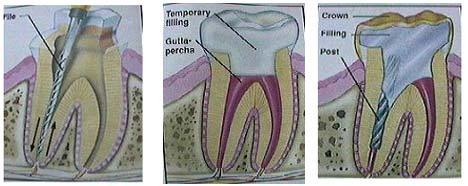
The goal of root canal therapy is to improve the health of your damaged tooth. During
treatment, the pulp is removed from your root canals through a small opening
in the crown. Then the canals are cleaned and disinfected. The adjoining diagram shows
an instrument being used to clean the canal. Treatment may take one or more visits.
The tooth is first numbed. An opening is made in your tooth and any existing fillings
or decay is removed. Then your dentist removes unhealthy pulp with tiny, flexible files.
Using delicate, up-and-down motions, your dentist gently cleans and smoothes your canals to disinfect them and prepares them for filling.
The canals are then sealed with an inert material that occupies the space vacated by the removal of the pulp.
After the inside of your tooth has been treated, the outside will be restored to protect your tooth’s underlying structures and to bring the tooth
back into function. Your dentist will usually cover the tooth with a ceramic or metal crown. After root canal therapy, your tooth continues to be
nourished
by the surrounding gums and bone.
After root canal therapy your tooth should function and feel like your other teeth. Take care of your treated tooth the same way you would your
other teeth. Brush after every meal, and floss before going to bed. Also, have regular dental checkups, cleanings, and any other dental work you
may need, so that your teeth last as long as you do!

Dental implants are a great way to replace missing teeth and also provide a fixed solution to having removable
partial or complete dentures. Dental implants are artificial roots and teeth (usually titanium) that are surgically
placed into the upper or lower jaw bone by a dentist or Periodontist – a specialist of the gums and supporting
bone. The teeth attached to implants are very natural looking and often enhance or restore a patient’s smile!
The process of getting dental implants requires a number of visits over several months.
X-rays and impressions (molds) are taken of the jaw and teeth to determine bone, gum tissue, and spacing available for an implant. While the area
is numb, the implant will be surgically placed into the bone and allowed to heal and integrate itself onto the bone for up to 3-6 months. The post
and anchor are already attached and placed at the same time.After several weeks of healing the artificial teeth are made and fitted to the post
portion of the anchor. After a healing period, the artificial teeth are securely attached to the implant, providing excellent stability and comfort to the
patient.
You will receive care instructions when your treatment is completed. Good oral hygiene, eating habits, and regular dental visits will aid in the life of
your new implant.
The newest and the latest in dentistry is the Dental Laser.Dental treatments with Laser is less painful so reduces the need of anaesthesia.It reduces
the anxiety in patients uncomfortable with the use of dental drill. It also minimizes bleeding and swelling during soft tissue treatments.Preserves
more healthy tooth during cavity removal.
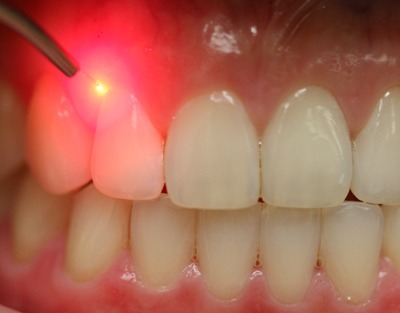
A laser is an instrument that produces a very narrow, intense beam of light energy. When laser light comes in contact with tissue, it causes a reaction.
The light produced by the laser can remove or shape tissue. Lasers can be used as a safe and effective treatment for a wide range of dental procedures
and are often used in conjunction with other dental instruments.
Dental lasers can be used to:
Gum disease is often caused by a build up of plaque bacteria, the best way to remove this is by twice daily tooth brushing. But no matter how well
you clean your teeth there will always be hard to reach areas that are tricky to keep clean. In these areas, plaque bacteria can accumulate and may
eventually mineralise to form a tough, crusty deposit called calculus or tartar, which is impossible to remove by brushing alone. If not removed, more
plaque can build up around the tooth and potentially under the gum line, leading to the progression of gum disease.
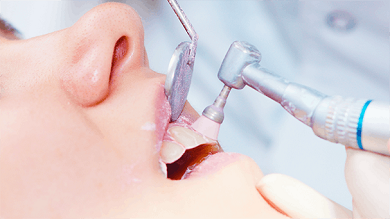
To reduce the risk of gum disease or to help stop it from becoming more serious, your dentist may recommend that you have a professional clean,
called a scale and polish, to get your teeth properly clean.
Rapidly evolving technology presents to us an amazingly effective and user friendly system to straighten crooked teeth without the use of braces.
The almost invisible custom fit snap on trays allow patient comfort and promote better oral hygiene while simultaneously helping to obtain a set of
well aligned teeth for that beautiful smile you deserve!

The Invisible System- With the aid of specialized software a well trained Orthodontist is able to provide specific, transparent plastic trays called
aligners which are custom made for an individual. The software program tooth movement and creates a series of aligners which one must wear as
advised by the experts. These trays help tooth movement in the desired position over a period of time. . Before starting the treatment itself one can
visualize the end result.
At Smile Care, a highly experienced Orthodonitst, well versed in modern Invisalign technology can achieve predictable results for his patients.
Full dentures, or complete dentures, are a removable device that can be used to replace missing teeth. The denture teeth are made out of porcelain
or acrylic and held together by an acrylic base. Partial dentures are similar but only used to replace some teeth, whilst a complete denture is a
replacement for the full set.
Full dentures may be needed when you lose all of your teeth and they can help fill out your appearance again, and leaving you feeling more confident
to smile.
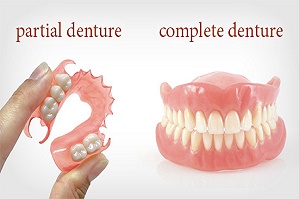
X-rays, also known as radiographs, are an essential part of any dental care treatment plan. They are diagnostic, but they can also be preventative, by
helping a dentist diagnose potential oral care issues in a patient’s mouth before they become a major problem. An x-ray is a type of energy that
passes
through soft tissues and is absorbed by dense tissue. Teeth and bone are very dense, so they absorb X-rays, while X-rays pass more easily
through gums and cheeks.
X-rays are divided into two main categories, intraoral and extraoral. Intraoral is an X-ray that is taken inside the mouth. An extraoral X-ray is taken
outside of the mouth.
Intraoral X-rays are the most common type of radiograph taken in dentistry. They give a high level of detail of the tooth, bone and supporting tissues
of
the mouth. These X-rays allow dentists to:
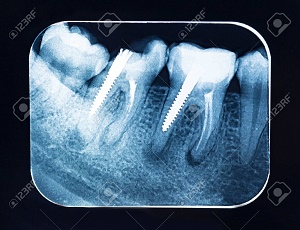
Bleaching is a process used to brighten your own natural teeth without any complications. No removal, cutting or etching of your dental enamel
takes place.Tea, coffee, red wine, tobacco, and the natural aging of the teeth turn them darker or stain them over time.A professional brightening is
performed with the aid of active oxygen, which decolorizes the distracting color pigments present in the tooth.
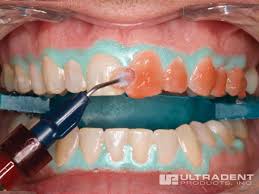
Smilecare offers affordable cosmetic and general dentistry with a personal touch and award winning customer service. who patients love for his
great communication skills and gentle, pain free dentistry. He’s the sole dentist at Smilecare and makes it possible for us to deliver high quality
cosmetic treatments at affordable prices.
techniques for teeth whitening, implants, clear braces and Botox are endorsed by the American Academy of Cosmetic Dentistry
and he’s also a talented practitioner of general dentistry such as fillings and bridges.

Smilecare has Plymouth’s only full time hygienist, so you can get your teeth professionally cleaned here when it suits you, not
according someone else’s timetable.

Both crowns and most bridges are fixed prosthetic devices. Unlike removable devices such as dentures, which you can take out and clean daily,
crowns and bridges are cemented onto existing teeth or implants, and can only be removed by a dentist.
A crown is used to entirely cover or “cap” a damaged tooth. Besides strengthening a damaged tooth, a crown can be used to improve its
appearance, shape or alignment. A crown can also be placed on top of an implant to provide a tooth-like shape and structure for function.
Porcelain or ceramic crowns can be matched to the color of your natural teeth. Other materials include gold and metal alloys, acrylic and
ceramic. These alloys are generally stronger than porcelain and may be recommended for back teeth. Porcelain bonded to a metal shell is
often used because it is both strong and attractive.
Bridges are commonly used to replace one or more missing teeth. They span the space where the teeth are missing. Bridges are cemented to the
natural teeth or implants surrounding the empty space. As with crowns, you have a choice of materials for bridges. Your dentist can help you decide
which to use, based on the location of the missing tooth (or teeth), its function, aesthetic considerations and cost. Porcelain or ceramic bridges can
be matched to the color of your natural teeth.
While crowns and bridges can last a lifetime, they do sometimes come loose or fall out. The most important step you can take to
ensure the longevity
of your crown or bridge is to practice good oral hygiene. A bridge can lose its support if the teeth or bone holding it in place
are damaged by dental
disease. Keep your gums and teeth healthy by Brushing with fluoride toothpaste twice a day and flossing daily.
Also see your dentist and hygienist
regularly for checkups and professional cleanings.
To prevent damage to your new crown or bridge, avoid chewing hard foods, ice or other hard objects.
A dental restoration or dental filling is a treatment to restore the function, integrity, and morphology of missing tooth structure resulting from caries
or external trauma as well as to the replacement of such structure supported by dental implants.
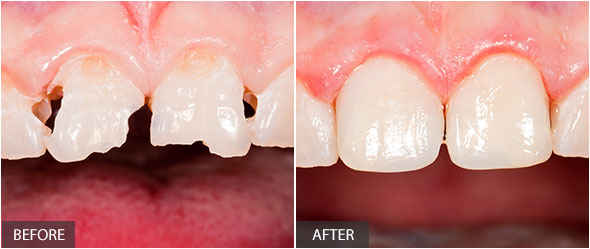

Teeth can be filled with gold, silver amalgam, or tooth-colored plastic materials called composite resin fillings. Crowns are a tooth-shaped "cap" that is
placed over a tooth to restore its shape and size, strength, appearance, to hold a bridge in place or cover a dental implant.
The tooth removal is a minor surgical procedure. While the great majority of extractions can be safely and painlessly carried out in the dental office,
some patients require hospitalization because of some medical problem.
With the advent of modern restorative techniques, a majority of teeth which were earlier advised for extractions, can now be easily saved. However,
in certain situations extractions are the only solution,
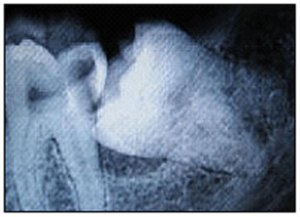
Wisdom teeth usually emerge from the gum (erupt) between the ages of 17 and 24. They are the last of the molar teeth. Some people never
develop wisdom teeth, others have four – one in each corner of the mouth. Wisdom teeth often cause no problems. They are described as
impacted when there is not enough space for them to erupt in the mouth.In such a case it might erupt towards the cheek or it might impinge
on the adjacent molar. Impacted wisdom teeth can cause pain, swelling, infection or damage to the teeth next to them. If the gum around the
wisdom tooth is swollen the jaw may become stiff and sore. Infection at the back of the mouth can cause bad breath and a bad taste. The
surgical removal (extraction) of one or more wisdom teeth can relieve these problems. People who have impacted wisdom teeth that are not
causing problems do not need to have them removed.
Full mouth rehabilitation is a highly individualized treatment. The point of a full mouth reconstruction plan is to optimize the health of the entire
mouth, including the teeth, the gums, and the bite. In many cases, it is necessary to replace or restore every tooth in the mouth using a combination
of dental services.
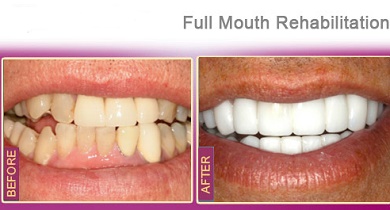
Pediatric dentists are dedicated to the oral health of children from infancy through the teen years. They have the experience and qualifications to
care for a child’s teeth, gums, and mouth throughout the various stages of childhood.
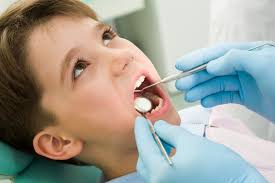
the various stages of childhood.Children begin to get their baby teeth during the first 6 months of life. By age 6 or 7 years, they start to lose their
first set of teeth, which eventually are replaced by secondary, permanent teeth. Without proper dental care, children face possible oral decay and
disease that can cause a lifetime of pain and complications. Today, early childhood dental caries—an infectious disease—is 5 times more common in
children than asthma and 7 times more common than hay fever.